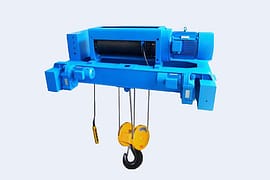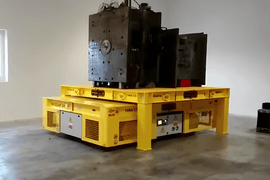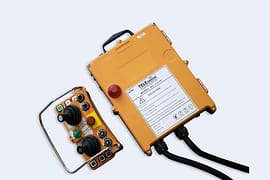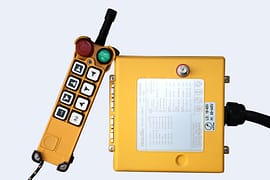How To Promote The Safe Operation Of Overhead Crane Systems In Industrial
Conduct of crane operators is outlined by the American Society of Mechanical Engineers (ACME B30.17-1992) to promote the safe operation of overhead crane systems in industrial environments. It instructs crane operators to remain focused on the safe operation of their overhead crane system by never engaging in any practice that could divert their attention while engaged in crane operation. However, some industrial environments can be hazardous, especially when working on a busy factory floor with multiple obstructions, or where visibility is low and stimuli is excessive.
Crane operators need to be fully aware of their surroundings at all times to safely and effectively operate overhead lift systems, particularly when fall protection is involved. The conduct of operators outlined by ASME includes the use of hand signals in busy industrial environments, even for operators using small or manual overhead crane systems.
People often make the mistake of thinking that hand signals only apply to large cranes where the operator sits in a cab. But, OSHA and ASME describe the use of hand signals as a necessary part of operator conduct when visibility is low due to multiple factors or when moving a load could create a potential hazard for operators or workers near the crane.
There are many potential safety concerns in industrial crane environments, and many can be mitigated by hazard elimination or the integration of engineering controls. OSHA¡¯s hierarchy of controls for general machinery and equipment specifies that we must first try to eliminate the situation, or second, employ engineering controls. But, in situations where hazards cannot be eliminated and engineering controls aren¡¯t an effective solution, administrative controls are a feasible option.
ADMINISTRATIVE CONTROLS
Administrative controls are based on the idea that crane operators should be able to see and communicate with workers at all times. This is a highly effective way of eliminating hazards like entanglement, which often occurs when workers¡¯ movements are relative to the load¡¯s movement. Other issues like dragging or pushing are a major concern because crane operators are usually focused on the load and not the crane¡¯s structure moving overhead. Structural impact is another concern, which often occurs when operators have low visibility or aren¡¯t able to control the load and maintain the relative position of nearby structures that could potentially impact the crane.
In cases like these, ASME recommends that operators respond to signals from a competent person who is directing the lift or an appointed signal person. When a signal person or director is not required as part of the crane operation, the operator is solely responsible for the lifts as well as the safety of nearby workers. Even so, all crane operators should know the importance of obeying a stop signal at all times, no matter who gives the signal on the factory floor.
If your factory does not require the use of signalers or directors, there are other steps you can take to improve the visibility of crane operators. These administrative controls can mean the difference between life and death, particularly in situations where the crane operator is the only source of visibility when controlling his or her load.
One administrative control, which can improve visibility in an industrial crane environment, is to designate zones for employees working near cranes. These zones should be designated on the ground or work platform so that workers are always standing in safe, visible positions. This ensures that your crane operators are aware of workers¡¯ positions at all times.
But, in factories where designating zones is not feasible, workers are using fall protection near overhead crane structures, or the hazard of structural impact is a potential issue, OSHA 1926.1425 clearly states that crane operators must be able to communicate with all workers at all times. If the factory floor is too loud for voice communication and devices like telephones and radios are not a viable option, ASME and OSHA both recommend the use of hand signals.
SO, WHEN SHOULD YOU IMPLEMENT HAND SIGNALS IN AN INDUSTRIAL CRANE ENVIRONMENT?
If an operator can¡¯t see workers behind him or the load, if the load is bulky or awkward and inhibits visibility, or if workers are constantly moving around the factory floor, signals are essential to ensure effective communication. Here¡¯s what OSHA 1926.1425 says:
The crane operator must be able to communicate with all workers at all times
Background noises must be kept to a minimum so voices can be heard.
Radio controls must be employed to insure 100 percent communication if voice commands cannot be heard due to background noise or distance.
A signaler may be required if the point of operation is not in full view of the operator.
Language must not be a deterrent to communication. All workers must be able to fluently speak and understand and communicate in one chosen language.
A ¡°lead¡± man must be designated to direct the lift.
The lead man is normally the primary person who communicates with the crane operator.
ASME states that signals must be fully discernable or audible to the operator. If your operator cannot hear workers on the factory floor at all times¡ªeven if audibility is only slightly hindered¡ªhand signals should be implemented.
HOW CAN YOU ENSURE EFFECTIVE IMPLEMENTATION OF HAND SIGNALS?
To start, ASME states that hand signals must be posted conspicuously around the facility, and a competent person should be in charge of giving them. Qualified crane operators should be very familiar with standard hand signals, along with the person giving the signals or directing the load. If special signals are needed, standard signals can be modified for special operations. The special signals must be agreed upon and understood by the signal person and operator. Special signals should NEVER conflict with standard signals. The crane operator should only obey hand signals from a competent, designated hand signaler or director. However, operators must always obey the “stop” signal and all workers should know how and when to use it appropriately.
For your convenience, we have included descriptions of standard hand signals for overhead crane operators. Signal persons should always wear proper personal protective equipment, and hand signals should be posted conspicuously as follows:
- HOIST:
With forearm vertical and forefinger pointing up, move hand in small horizontal circle. - LOWER:
With arm extended downward and forefinger pointed down, move hand in small horizontal circle. - BRIDGE TRAVEL:
With arm extended forward and hand open and slightly raised, make pushing motion in direction of travel. - TROLLEY TRAVEL:
With palm up, fingers closed, and thumb pointed in direction of motion, jerk hand horizontally. - STOP:
With arm extended and palm down, move arm back and forth horizontally. - EMERGENCY STOP:
With both arms extended and palms down, move arms back and forth horizontally. - MULTIPLE TROLLEYS:
Hold up one finger for block marked “1” and two fingers for block marked “2”. Regular signals follow. - MOVE SLOWLY:
Use one hand to give any motion signal and place the other hand motionless in front of the hand giving the motion signal. (Hoist slowly shown as an example.) - MAGNET IS DISCONNECTED:
Crane operator spreads both hands apart, with palms facing up. Do not confuse this signal with the emergency stop signal. 
























































































































